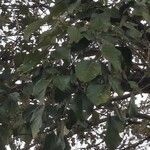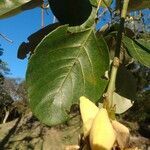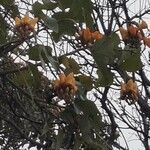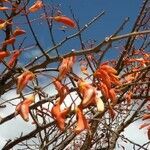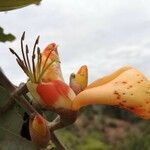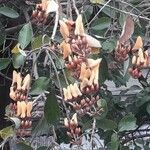An evergreen tree. It grows to 5-26 m high and spreads to 3 m across. Trees can lose their leaves. The stem is erect and sturdy and has prickles along it. The trunk branches and forks and can be crooked. It can have buttresses. The bark is grey or green and is cracked and flaky. The leaves have 3 leaflets. They are yellowish green on top and with a bluish green bloom underneath. They are thick and oval and 2.5-15 cm long by 1.4-15 cm wide. The leaf stalks are 1-19 cm long have prickles. The flowers are pea shaped and scarlet. They occur in large branching sprays at the ends of branches. This flower spray stalk is 8-13 cm long with flower stalks 3-13 cm long. The flower standard is bright orange-red. It is 4-7 cm long and 4-6 cm wide. The fruit are pods which have stalks. The pods are 14-33 cm long and 1.4-1.8 cm wide. There are 6-12 seeds in a pod. The pod is slightly constricted between the seeds. They are densely velvety. The seeds are dark brown and oblong. They are 1.2-1.8 cm long by 5-8 mm wide.
Large trees. Leaves with the leaflets ovate to oblong, 7-14 cm long, 5-11 cm wide, round obtuse apically, obtuse to vaguely cordate basally, thin coriaceous, minutely bullate, usually green, glabrous above, puberulent to minutely farinose below, the principal secondary veins, 6-9, the costa prominulous above, often aculeate; petioles 9-13 cm long, ca. 0.3 cm wide, minutely puberulent to glabrous; rachises 8-25 cm long, pubescent, often acufleate. Inflorescence with bracts and bracteoles ovate or broadly ovate, to 2 mm long; pedicels to 2 cm long and 0.2 cm wide. Flowers with the calyx broadly campanulate, to 17 mm long, asym-metric, longer on the lower side, chartaceous, pubescent, the hairs deciduous, the teeth scarcely evident; standard orange, trapeziform, to 90 mm long and 40 mm wide, widely deltoid apically, obtuse basally, coriaceous, glabrous, the claw
ca. 20 mm long, the wing petals obliquely semicircular, ca. 25 mm long and 20 mm wide, obliquely rounded apically, the claw scarcely evident, the keel petals connate, ovate falcate, about twice the length of the wing petals, 12-17 mm wide, truncate, oblique basally; staminal sheath ca. 17 mm long, coriaceous, glabrous, the filaments crassate, ca. 1 mm wide, the anthers ca. 4 mm long, the odd stamen ca. 35 mm long; ovary stipitate for ca. 15 mm, linear, ca. 10 mm long, puberulent, the style linear subulate, ca. 15 mm long, erect. Legume with the stipe linear cuneate, ca. 3 mm long, moniliform, ca. 20 cm long and 1.5 cm wide, the beak ca. 2 cm long, falcate, farinose; seeds ca. 1.5 cm long and 0.7 cm wide, opaque, drying brown, smooth, hard, the scar to 0.7 cm long.
Pending.
